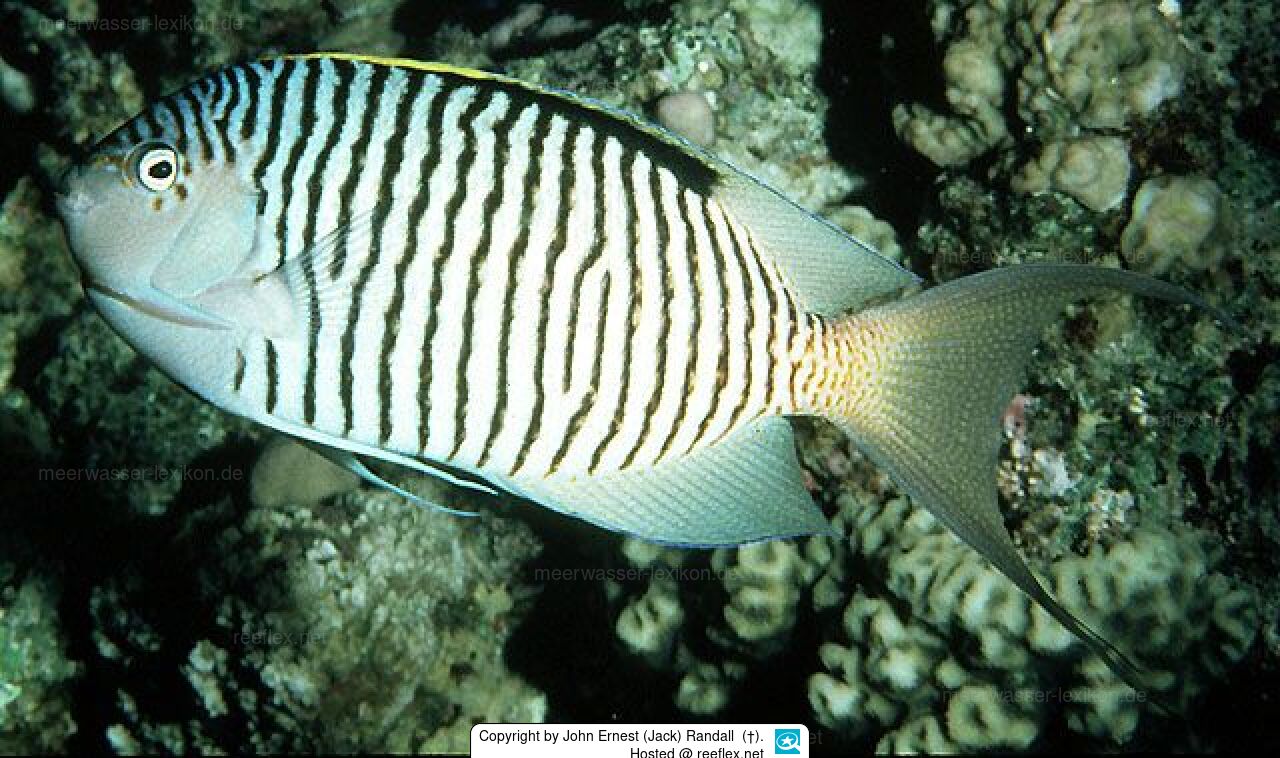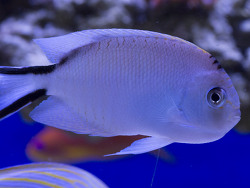Info
(Günther, 1860)
Genicanthus caudovittatus also known as Zebra angelfish is found in Indo-Pacific Ocean and Red Sea as well as along the East Coast of Africa including Maldives, Madagascar, Reunion, and Mauritius. Inhabit steep slopes between 25 - 50 m, single males are usually seen with several females,
Zebra angelfish males recognized by the zebra-like stripes and black streak along the base of the dorsal fin. Females body overall is grey with black streaks along the caudal fin. Feeds mainly on plankton, crustaceans, and macro algae in the wild. Genicanthus caudovittatus needs a varied diet and numerous feedings per day. Feed prepared and frozen foods in captivity, as well as providing live rock to graze upon.
Most angelfish are not known as reef-safe but angels from the genus Genicanthus will leave your corals and sessile invertebrates alone. There are not many angelfish appropriate for the reef tank, of the ones that are, the Zebra angelfish is one of the best and well suited for the reef aquarium.
Synonyms:
Centropyge caudovittatus (Günther, 1860)
Genicanthus caudibicolor (Lienard) Sauvage, 1891
Holacanthus caudibicolor Sauvage, 1891
Holacanthus caudovittatus Günther, 1860
Holacanthus zebra Sauvage, 1891
Classification: Biota > Animalia (Kingdom) > Chordata (Phylum) > Vertebrata (Subphylum) > Gnathostomata (Superclass) > Pisces (Superclass) > Actinopteri (Class) > Perciformes (Order) > Percoidei (Suborder) > Pomacanthidae (Family) > Genicanthus (Genus) > Genicanthus caudovittatus (Species)
hma
Genicanthus caudovittatus also known as Zebra angelfish is found in Indo-Pacific Ocean and Red Sea as well as along the East Coast of Africa including Maldives, Madagascar, Reunion, and Mauritius. Inhabit steep slopes between 25 - 50 m, single males are usually seen with several females,
Zebra angelfish males recognized by the zebra-like stripes and black streak along the base of the dorsal fin. Females body overall is grey with black streaks along the caudal fin. Feeds mainly on plankton, crustaceans, and macro algae in the wild. Genicanthus caudovittatus needs a varied diet and numerous feedings per day. Feed prepared and frozen foods in captivity, as well as providing live rock to graze upon.
Most angelfish are not known as reef-safe but angels from the genus Genicanthus will leave your corals and sessile invertebrates alone. There are not many angelfish appropriate for the reef tank, of the ones that are, the Zebra angelfish is one of the best and well suited for the reef aquarium.
Synonyms:
Centropyge caudovittatus (Günther, 1860)
Genicanthus caudibicolor (Lienard) Sauvage, 1891
Holacanthus caudibicolor Sauvage, 1891
Holacanthus caudovittatus Günther, 1860
Holacanthus zebra Sauvage, 1891
Classification: Biota > Animalia (Kingdom) > Chordata (Phylum) > Vertebrata (Subphylum) > Gnathostomata (Superclass) > Pisces (Superclass) > Actinopteri (Class) > Perciformes (Order) > Percoidei (Suborder) > Pomacanthidae (Family) > Genicanthus (Genus) > Genicanthus caudovittatus (Species)
hma







 Dr. John Ernest (Jack) Randall (†), Hawaii
Dr. John Ernest (Jack) Randall (†), Hawaii



























